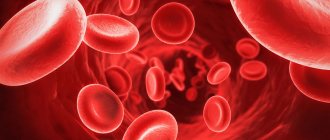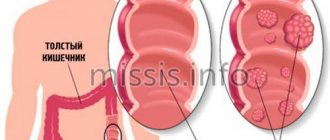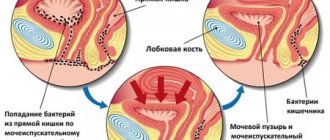What does high cholesterol mean?
Elevated cholesterol
Elevated cholesterol is considered when the levels exceed the norm by a third or more. In this case, the use of medications and diet are required. A normal level is considered to be a cholesterol level of more than 5 mmol/l. But not all substances are considered dangerous to the body, but only low-density lipoproteins. This is due to the fact that they tend to settle on the walls of blood vessels, clogging them.
Blood clots form on the surface of the plaque over time. As a result, the vessel becomes narrower, and blood stops flowing in sufficient quantities to the organs. In cases where a heart vessel is damaged, blockage can lead to heart attack and stroke.
The disease develops slowly and occurs at the initial stage without pronounced symptoms. Symptoms appear only after the lumen of the vessel has decreased by more than half.
All manifestations of the disease depend on which vessel was damaged. But often the lack of treatment leads to death. Elevated cholesterol is most often found in middle-aged patients, but can also occur in children.
Properties of cholesterol in the body in women
Cholesterol is an alcohol that contains fats. Cholesterol molecules accompany the human body from birth to the last day of life. 1.0 grams of cholesterol molecules are synthesized in 24 hours.
The main part of lipids in the female body is produced by liver cells, this amounts to 50.0%, up to 20.0% is absorbed into the blood from the small intestine, the remaining lipid molecules enter the blood plasma from the skin, adrenal glands, as well as their female reproductive glands .
The metabolic process is quite complex, it involves more than 100 reactions, and more than 300 different proteins and protein compounds take part in the synthesis.
Cholesterol can only be transported throughout the body by lipoprotein molecules.
Low molecular weight lipoprotein delivers cholesterol to every cell of the female body, and high molecular weight lipoprotein (HDL) collects unused fat and transports it back to the liver cells for further utilization with the help of bile acid.
Low cholesterol leads to lipid metabolism disorders, when there is a decrease in high molecular density lipoproteins and an increase in the concentration of low density lipids.
Reduced cholesterol
Causes of high cholesterol
Fast food
Why does cholesterol increase in women and men? The likelihood of increased levels of a substance in the body increases in the presence of a genetic predisposition. In most patients, it was noted that close relatives suffered from coronary heart disease or atherosclerosis.
The risk of high cholesterol also increases with age. Also the main reasons are:
- Wrong lifestyle and bad habits. These include smoking and alcohol abuse. Many patients often consume fast food and fast food, which contain huge amounts of fat and carcinogens.
- Systemic pathologies, among which diabetes or obesity play a major role.
- Sedentary lifestyle. Staying in one position for a long time. Provokes congestion in blood vessels.
Frequent stressful situations and depressive states also provoke an increase in blood cholesterol levels.
Interesting facts about cholesterol and cardiovascular disease
Recent research suggests that higher cholesterol levels in and of themselves are not a risk factor for heart disease, and it may even be beneficial for cardiovascular health - especially when it comes to high cholesterol in women.
According to world-renowned heart surgeon Dwight Lundell, inflammation in the arteries is a major risk factor for developing cardiovascular disease. He says that "without inflammation, cholesterol will move freely throughout the body, as nature intended." Excessive consumption of processed foods and fast foods high in trans fats, omega-6 fatty acids and other harmful components is a major dietary contributor to arterial inflammation.
Until the 1950s, there was little talk about the fact that butter and fatty meats caused heart disease. Then a study was conducted on rabbits in 1955 - the rabbits were fed meat and foods high in cholesterol. They all died. After this, the message began to spread that people should reduce their fat intake or face the same fate. However, for some reason the researchers did not say that rabbits are herbivores and cannot digest meat, so such statements were completely unfounded in relation to humans.
Here are some interesting facts for you:
- Cholesterol is a naturally occurring substance within our bodies and is essential for countless functions.
- Without it, our body cannot create the outer membrane of the cells that make up almost every part of our body.
- Cholesterol is essential for proper brain and hormonal function, strong bones and a healthy immune system.
Bottom line: Cholesterol is vital to human health.
Main signs of high cholesterol
Angina Pectoris
Exceeding the norm of cholesterol in the blood is determined by a laboratory blood test. Also, deviation from the norm can be determined by the following signs:
- Angina pectoris. It occurs as a result of narrowing of the lumen of the coronary vessels.
- Painful sensations in the lower extremities, aggravated by exercise.
- Rupture of blood vessels, which manifests itself in the form of bruises and hematomas.
- Determining the presence of blood clots in the veins.
- Heart failure, the development of which occurs as a result of rupture of cholesterol plaques.
- The appearance of yellow spots on the skin in the eye area.
High cholesterol in women and men has no symptoms in itself; symptoms occur against the background of the development of atherosclerosis. The disease is a complication of increased levels of the substance in the blood. That is why doctors recommend regularly taking tests to determine the amount of cholesterol.
Why is the level rising?
Causes may be hereditary or acquired. The genes responsible for pathological cholesterol production are inherited from parents. If immediate relatives suffered from hyperlipidemia, then the chance of an increased level of the substance in the child increases.
In addition, according to statistical data, this pathology is observed more often in men than in women. It is also noted that with age, the likelihood of atherosclerosis increases. Starting from the age of 20, the content of this substance in the body begins to increase naturally, regardless of weight indicators and food preferences. In men, the increase is observed until approximately 50 years of age; in women, it can increase sharply due to menopausal changes. Also, higher levels of the substance are observed in certain ethnic groups, which is not observed in other nations.
In addition, diseases that can be treated can affect the content of the substance:
- dysfunction of the thyroid gland (hypothyroidism);
- hypertonic disease;
- kidney and liver diseases;
- carbohydrate metabolism disorder – diabetes mellitus;
- receiving certain medications for a long time.
Changes in cholesterol levels may also be affected by:
- Low physical activity. Much more often, increased levels of “bad” cholesterol are observed in those people who spend most of their time sitting or lying down, while at the same time the content of “good” cholesterol is reduced.
- Poor nutrition and preference for fatty foods is one of the main factors influencing cholesterol levels. At the same time, the increase in the level of the substance is negatively affected by food products that contain saturated fats - processed meat, smoked meats, confectionery and flour products.
- Excess weight, in which there is a decrease in the level of “good” cholesterol and an increase in “bad” cholesterol.
- The presence of bad habits - addiction to alcohol and smoking - contributes to a significant increase in LDL levels.
Why is high cholesterol dangerous?
Excessive cholesterol levels primarily cause the development of atherosclerosis. The pathology is characterized by the appearance of plaques on the walls of blood vessels. They provoke circulatory problems, and if they come off, they can enter any artery and penetrate the brain. That is why its quantity should be reduced.
One of the serious consequences of high cholesterol is stroke. A heart attack or heart failure may also develop. If left untreated, the disease becomes fatal.
What is cholesterol for?
Cholesterol is a wax-like substance that is produced mainly in the liver and is one of the components of cell membranes.
This lipid is also capable of being produced by the kidneys, adrenal glands, and some organs of the reproductive system. Our body independently synthesizes up to 80% of the substance, the rest of the body receives from food. Cholesterol takes part in many processes occurring in the body:
- it takes part in the formation of cell membranes, maintains and controls their permeability, blocks the process of crystallization of hydrocarbons;
- takes part in the production of hormones, including testosterone;
- necessary for metabolic processes;
- promotes the production of vitamin D;
- necessary for cell renewal;
- is an insulator of nerve fibers.
It is worth noting that cholesterol itself cannot be absorbed in the body; there are its compounds, which are called lipoproteins. Lipoproteins exist in high and low density.
HDL is called “good” cholesterol and is considered a sign of good health. It is this type of cholesterol that performs the functions that we talked about. HDL does not participate in the formation of plaques, does not lead to clogging of the lumens in the blood vessels, this cholesterol actually protects the body from destruction. Moreover, high-density lipoproteins return the substance back to the liver, where it breaks down, or its excess content is removed from the body.
At the same time, LDL is considered “bad” cholesterol. Low-density lipoproteins deliver substances from the liver to other organs. An excess of these cells causes harm to the body - plaques begin to form on the walls of blood vessels, which ultimately leads to serious health consequences - a heart attack or stroke.
How to reduce
Mertenil
Before you begin measures to normalize cholesterol levels, it is necessary to identify the reasons for its increase. Patients are often advised to follow a diet and perform gymnastic exercises.
If the norm is significantly exceeded, drug treatment is prescribed. All drugs are selected strictly on an individual basis, depending on age and the presence of concomitant pathologies.
The main drugs for lowering blood cholesterol are statins. The action of the active substances is aimed at blocking liver hormones that are involved in the production of the substance. The most effective are Mertenil and Lipikor.
These drugs are prescribed to patients whose medical history contains data on the presence of diseases of the heart muscle, diabetes mellitus, and a genetic predisposition to the development of atherosclerosis.
The drugs should be taken only as prescribed by a doctor, as there are side effects. These include headache, flatulence, and tingling in the intestines. The dosage is also determined by a specialist.
How to determine your cholesterol level
The only way to determine cholesterol levels is through laboratory methods.
The following blood tests are performed:
- total cholesterol;
- determination of LDL, HDL;
- triglyceride test.
The total cholesterol blood test is the most commonly used biochemical test. If values exceed 5 mmol/L, a more detailed examination may be required, for which the blood is tested for LDL and HDL lipid levels.
Triglycerides are a type of fat that is converted into energy when ingested by the body. These fats are primarily deposited on the thighs and abdomen, contributing to the development of obesity. Therefore, a high level of triglycerides in the blood indicates a high risk of cardiovascular pathologies.
Hereditary predisposition will help to identify a genetic study, which determines the presence of genes responsible for hypercholesterolemia.
Experts recommend getting your cholesterol levels checked every 5 years after age 20.
Features of increased cholesterol in men, women and children
The level of the substance depends not only on the age, but also on the gender of the person. It has been noted that cholesterol increases most in men after 35 years of age. This is due to the fact that among them there are often smokers and alcohol drinkers.
In women, excess of the norm is detected more often after menopause or with the development of diseases of the intestines and other organs of the digestive tract. In addition, an increase in cholesterol levels occurs during pregnancy.
Excessive amounts of the substance are also observed in children, which can lead to the development of serious disorders at an older age. Cholesterol accumulates on the walls of blood vessels over time, and by the age of 13-15 plaques form. Parents suffering from diseases of the cardiovascular system should pay special attention to the nutrition of their children and prevent excess weight.
Treatment
Treatment is prescribed after determining the cause of the increase in cholesterol levels. You can normalize the indicators:
- by medication;
- without the use of medications.
When prescribing drug therapy, the doctor takes into account the cause of the increase in the substance, age, concomitant diseases, and the individual properties of the patient’s body. Therefore, there can be no talk of any self-medication.
In this case, specialists prescribe:
- Statins, which promote the breakdown of lipids. These drugs block the enzyme that produces cholesterol. Drugs of this pharmacological group are used for preventive purposes, as well as for therapeutic purposes in atherosclerosis. These drugs include: pravastatin, lovastatin, simvastatin and others. Side effects of their use include intestinal dysfunction, headaches, and abdominal pain. Statins can normalize cholesterol levels, thereby increasing the patient’s quality of life.
- Fibrates can increase the content of “good” cholesterol, while reducing triglycerides, which contribute to the accumulation of fatty tissue in the abdomen and thighs. This is clofibrate, fenofibrate.
- Niacin helps reduce both types of cholesterol. High doses of this B vitamin are available only with a doctor's prescription. The use of the drug may cause itching, tinnitus, and headaches.
- Drugs prescribed for hypertension also help reduce the content of the substance;
- Absorption inhibitors show positive results when taking foods with cholesterol, without affecting blood cholesterol levels. In addition, they must be taken in full accordance with the instructions, and the drugs themselves have many side effects, so they are prescribed quite rarely.
Prevention
Healthy lifestyle
In the fight against high cholesterol, it is also important to adhere to preventive measures. They are aimed not only at maintaining its level, but also at restoring the normal amount necessary for the functioning of the body. Experts advise middle-aged patients and people at risk to follow the following recommendations:
- Lead a healthy lifestyle. The basis of health is proper nutrition, physical activity and giving up bad habits. Patients should also follow a daily routine. Adequate sleep is the key to not only physical health, but also moral health.
- Avoid stressful situations. It is not possible to completely eliminate them from life, but it can be minimized. To cope with emotions, you should take sedatives that contain natural ingredients.
- Eat properly. You should limit the amount of fatty foods and foods high in cholesterol. Abandoning them completely is also harmful.
- Move more. Most people lead a sedentary lifestyle, which can result in elevated levels of the substance. To prevent their occurrence, regular and moderate physical activity is necessary.
- To refuse from bad habits. Drinking alcohol and smoking can aggravate the course of various diseases and cause the formation of cholesterol plaques.
- Watch your weight. Extra pounds or obesity become the main cause of increased cholesterol in the blood and the development of atherosclerosis.
- Visit your doctor regularly. Once a year you should donate blood to determine your cholesterol level. Timely identification of deviations from the norm will help to immediately begin treatment and eliminate the occurrence of serious consequences.
An increase in normal cholesterol levels always indicates a malfunction of certain organs. That is why, if a patient adheres to proper nutrition and a healthy lifestyle, but cholesterol levels increase, he should consult a doctor.
According to experts, an increase in the substance in the blood is the reason for inattention to one’s health. First of all, to prevent an increase in indicators and the development of atherosclerosis, you should eat right and exercise.
Proper nutrition
Products with natural statins help lower blood cholesterol. In addition, experts recommend the following products for consumption:
Citrus fruits (grapefruits, lemons, oranges). These fruits contain ascorbic acid. It has a positive effect on blood vessels and heart muscle, which leads to the production of “good” cholesterol. In addition, they have a beneficial effect on the general condition of the body.
- Garlic.
- Cereals. These crops contain a lot of fiber. It displaces cholesterol into the gastrointestinal tract, from where the substance has no way to penetrate the blood vessels.
- Fatty fish.
- Beans, peas.
- Artichokes, basil.
Drug treatment can be avoided if you plan your nutritional diet correctly. A healthy lifestyle and giving up bad habits are very important. Before solving the problem, the doctor must draw up a complete clinical picture of the disorder. Only after this can he decide on treatment tactics.
Diet for high cholesterol
Diet does not play the most important role in regulating cholesterol levels. This is due to the fact that only 20% of the substance enters the body along with food. But many of them contribute to its removal. In order to normalize cholesterol levels, you should avoid the following foods:
- mayonnaise;
- margarine;
- egg yolk;
- liver;
- fatty meats.
It is also recommended to avoid high-fat dairy products. Low-fat cottage cheese, fresh vegetables and fruits are useful. You should add more plant foods to your diet. It is better to choose lean meat. Beef, chicken and turkey will do.
High cholesterol is unhealthy and life-threatening. When the norm is exceeded, plaques appear in the vessels, which settle on the walls of the veins, narrowing their lumen. To exclude the development of atherosclerosis, you should follow the recommendations of doctors and regularly have your blood tested. If the norm is exceeded, you should follow a diet, exercise and take medications prescribed by your doctor. Lack of therapy can lead to the development of atherosclerosis and cause a heart attack or stroke.
Features of pregnancy with high cholesterol
While carrying a baby, every expectant mother should undergo regular examinations for timely detection of various disorders. Pregnant women often pay attention to elevated cholesterol values in a biochemical blood test. There is no need to worry about this. A physiological factor plays a role here.
Cholesterol levels may increase in the blood during pregnancy
An increase in the amount of this substance in the blood of the expectant mother is considered a normal phenomenon caused by changes in hormonal levels. For the correct development and growth of the baby, the woman’s body slightly changes its usual working rhythm and adapts to the changes that are taking place.
Fat metabolism in the system increases, blood composition changes, and progesterone synthesis increases. All changes are necessary for the normal course of pregnancy. Therefore, if the cholesterol level of the expectant mother is within 4-6 mmol/l, no measures should be taken. Such values are considered normal.
An additional examination may be prescribed if the cholesterol level exceeds 10 mmol/l. A similar situation can occur with pathologies of the heart and blood vessels, liver, and endocrine system in the expectant mother. An increased concentration of lipoproteins can also negatively affect the baby’s health.
Drug therapy to lower cholesterol during pregnancy is used only in extreme cases. Basically, they try to eliminate the problem by adjusting the diet, eliminating or replacing certain foods. After childbirth, the results of a blood biochemistry test for cholesterol levels will be normal.
A slight increase in cholesterol levels in the blood of a pregnant woman is considered normal.
How to eat properly for people with high cholesterol?
Animal products are saturated with fats that are harmful to the body, which increase the level of low-density lipoproteins. Therefore, their use should be abandoned.
To normalize cholesterol levels, you need to eat right
Properly formulated will help bring cholesterol concentrations to normal levels. Fiber helps reduce the amount of low-density cholesterol. It has unique properties and can significantly reduce the absorption of cholesterol in the digestive tract.
Of particular benefit will be soluble fiber contained in fruits, barley and oat grains, legumes, and seaweed. Experts recommend regularly eating grapefruits and apples. Among vegetables, preference should be given to carrots, beets, cabbage, and green peas. You need to consume at least 400 g of them per day (raw).
There is no need to completely give up meat. The diet is allowed to include lean meat of chicken, turkey, rabbit, lean lamb and beef. Before heat treatment, be sure to remove the skin from the bird.
Nuts will help remove excess cholesterol from the system. They contain many beneficial substances, antioxidants and polyunsaturated fatty acids.
Thanks to the presence of vitamin E in nuts, vascular walls are strengthened. Phospholipids reduce the level of low-density lipoproteins.
Another useful product is garlic, which is able to regulate cholesterol levels. A plant from the onion family has a positive effect on the entire cardiovascular system.
Proper nutrition and diet will help regulate cholesterol levels.
Clinical manifestations of the disease
At the initial stage, the pathological phenomenon does not manifest itself externally. This contributes to the further development of the disease and increases the risk of severe health consequences. Diseases that have already occurred against this background may indicate high cholesterol.
Elevated cholesterol levels are accompanied by a number of symptoms
Experts say that the body can give advance signals about the development of pathology. One of the first signs that you should pay attention to is pain in the heart area - angina pectoris.
The syndrome is associated with a significant narrowing of the lumen of the coronary arteries. The reason for this is the deposition of low-density lipoproteins on the walls of arteries and vessels.
During physical activity, pain in the limbs or weakness may appear. This condition is also associated with the deposition of cholesterol on the walls of blood vessels and the resulting narrowing of the lumen. This leads to a deterioration in the blood supply to the lower extremities and the appearance of characteristic symptoms.
When lipid metabolism is disrupted, neoplasms appear on the skin - xanthomas, which contain cholesterol. They are usually localized around the eyes, near the eyelids. In appearance, xanthomas are a small subcutaneous soft vesicle that has a yellowish tint. When cholesterol levels normalize, xanthomas usually disappear.
Read: Scleroderma focal. Treatment and prevention
Usually, the first sensations of malaise appear when atherosclerotic plaques are formed. Body signals cannot be ignored. The pathological condition requires medical diagnosis.
High cholesterol does not have characteristic severe symptoms.
Causes of hypercholesterolemia
The etiology of high cholesterol concentration may be a hereditary factor. This form of pathology is defined as primary or familial. It detects high cholesterol in children. The disease is caused by the fact that the baby receives from his parents a defective gene that is responsible for lipid synthesis, therefore a pathological concentration of fat-like compounds is diagnosed in his body.
It should be noted that quite often high cholesterol in children is not detected, since everything goes away without clinical symptoms. The problem becomes noticeable in later life.
Secondary forms of the disease develop when exposed to certain factors that act as catalysts or risk factors:
- disturbances in liver function;
- stress and nervous tension;
- age after 55 years;
- gender (total cholesterol is increased more often in men);
- smoking;
- nutritional factor - excessive consumption of fatty and high-calorie foods;
- physical inactivity.
How to normalize an indicator
Medicines are prescribed by the doctor after examination
To treat hypercholesterolemia, it is important to use not only certain medications, but also lifestyle changes. Drug therapy involves the use of statins and fibroic acids.
Of the statins, the following drugs have gained the greatest popularity in the treatment of high cholesterol: Baykol, Lexol, Mevacor, etc.
The use of fibroic acids also helps reduce cholesterol concentrations. Such drugs are: Fenofibrate, Clofibrate, Gemfibrozil, etc.
Drug treatment also includes the use of omega-3 polyunsaturated fatty acids.
Ezetimibe is used to block the absorption of lipids in the intestine. This drug is not very effective, but in rare cases it causes side effects, unlike statins. In severe cases, extracorporeal methods are used.
Traditional methods of reducing blood cholesterol
Garlic tincture is an effective remedy against cholesterol
If the concentration of lipids in the blood exceeds the norm, then along with drug treatment you can use traditional methods:
- Garlic infusion. Take 10 cloves of garlic and squeeze through a press. Next, pour in olive oil (2 cups). Cover the mixture well and leave to infuse for a week. The prepared infusion is used as a seasoning for food.
- Calendula infusion. You can buy a ready-made infusion at the pharmacy. It is taken for a month, 30 drops.
- Infusion of celandine. Grind one gram of dry celandine leaves and pour a glass of boiling water. Cool and strain. Take a teaspoon orally 3 times a day. It should be remembered that the plant is poisonous.
- As a spice, it is useful to use milk thistle seeds and three-leaf leaves. Chop them and sprinkle on dishes after cooking.
The methods listed above can reduce the risk of plaque formation and remove toxins from the body.
When using traditional methods of treatment, you should consult your doctor. If the course of treatment is long, you should be examined every 6 months.












